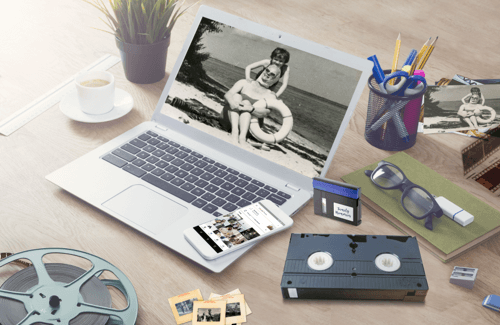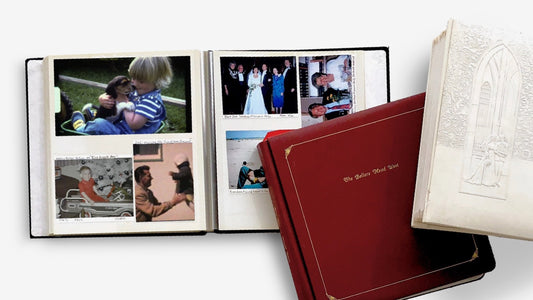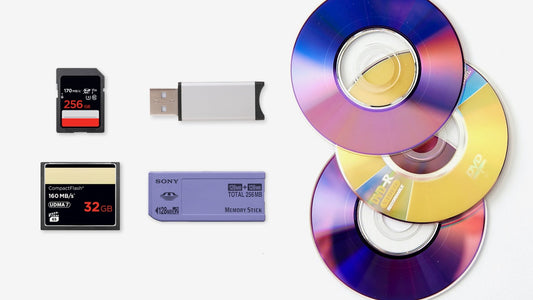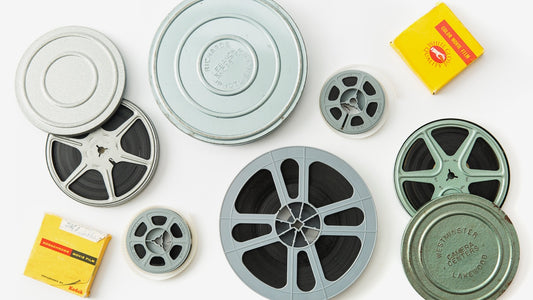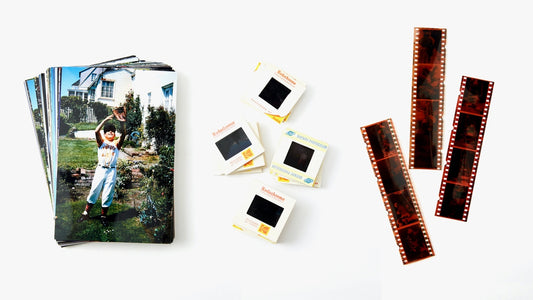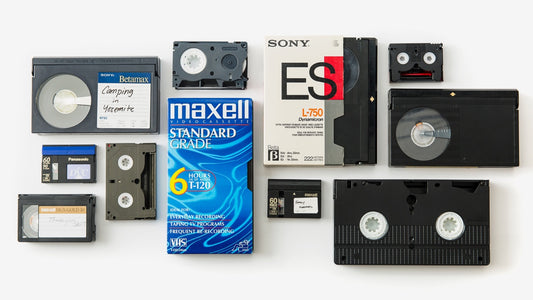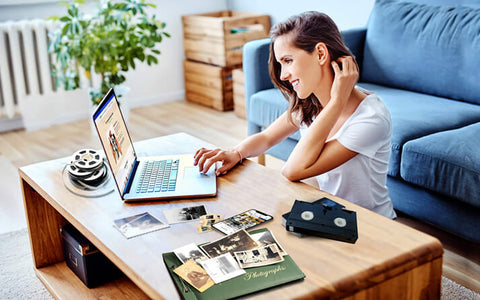Your wedding video, your child's first steps, those unforgettable family vacations—they're all on VHS tapes, likely collecting dust and slowly degrading. But those precious memories don't have to be lost forever. The best way to preserve them is to change VHS to digital, giving your home movies a permanent, shareable home. This guide will walk you through how to convert VHS to digital using both professional services and DIY tools. I’ll also share my go-to tips for prepping your tapes to get the best possible quality and managing your newly digitized collection.
Key Takeaways
- Preserve your memories by converting VHS tapes to digital. Time, moisture, and temperature changes damage VHS tapes. Digitizing ensures your home movies are safe and accessible for years to come.
- Digital videos are easier to access and share. No more searching for a working VCR! Enjoy your digitized videos on modern devices and easily share them with family and friends.
- Choose the conversion method that's right for you. From professional services like YesVideo to DIY options, select the method that aligns with your technical skills, budget, and available time.
What Does It Mean to Digitize Your VHS Tapes?
VHS to digital conversion is the process of transferring the video content from your old VHS tapes into a digital format. Think of it like moving your home movies from a clunky, outdated storage box into a sleek, modern computer file. This ensures your precious memories are safe, easily accessible, and ready to share with loved ones. After the VHS conversion, you can store those files on a hard drive, USB flash drive, DVD, or in cloud storage.
This conversion is essential because VHS tapes degrade over time. They're susceptible to physical damage, and the magnetic tape inside can deteriorate, leading to a loss of video and audio quality. Digitizing your tapes protects your memories from the effects of aging and ensures they remain vibrant for years to come. Plus, let's be honest, who even has a working VCR anymore? Transferring your videos to a digital format makes them viewable on modern devices like computers, smartphones, and smart TVs. You can even easily share those special moments with family and friends.
Why It's Time to Digitize Your VHS Tapes
Let's be honest, those VHS tapes stacked in your closet aren't getting any younger. Digitizing them isn't just about updating the format; it's about safeguarding your memories. Here's why making the switch from VHS to digital is so important:
Stop Your Memories from Fading
Time, moisture, and even temperature fluctuations can damage VHS tapes. That fuzzy picture and distorted sound? It only gets worse. Digitizing your tapes protects your memories against the ravages of time. Those precious moments, from birthdays to graduations, deserve to be preserved. Once they're digital, you can rest easy knowing they're safe and sound.
The Limited Lifespan of VHS Tapes
VHS tapes were never meant to last forever. The magnetic tape inside them starts to degrade after about 10 to 25 years, causing color loss, fuzzy images, and distorted audio. Every time you press play, the tape wears down just a little bit more, meaning your cherished home movies are in a constant state of decay. Digital files, on the other hand, don't degrade over time. Converting your tapes to a digital format essentially freezes them, creating a permanent, high-quality copy that you can enjoy for decades without any further loss of clarity.
The Disappearing VCR
Even if your tapes are in pristine condition, you face another major hurdle: finding a way to play them. VCRs have gone the way of the dinosaur. Manufacturers stopped making them years ago, and finding a reliable, working player is becoming increasingly difficult and expensive. The simple truth is that most of us don't have a working VCR anymore. Without the right hardware, your tapes are essentially unwatchable memories collecting dust on a shelf. Digitizing your collection makes your videos accessible again, allowing you to watch them on any modern device, from your laptop to your smart TV—no ancient equipment required.
Watch Your Videos Anywhere, Anytime
Remember the last time you actually watched a VHS tape? Digitizing your videos makes them instantly more accessible. No more searching for a working VCR! You can watch your digitized videos on your computer, TV, tablet, or phone. Plus, sharing becomes easy. Send a digital copy to family and friends, or upload them to a cloud service so everyone can enjoy them anytime.
Clear Out the Clutter
Let's face it, VHS tapes are bulky. Boxes and boxes of them take up valuable storage space. Digitizing frees up that space. Plus, digital files are much easier to organize. No more sifting through stacks of tapes to find the one you're looking for. With digital files, everything is neatly organized and easily searchable. You can even create playlists and compilations of your favorite moments.
How to Change VHS Tapes to Digital: Your Options
Ready to digitize those VHS tapes? You have a few options, from hands-off professional services to setting up your own DIY system. Let's break down each method:
Let the Pros Handle It
If you're short on time or technical skills, using a professional service like YesVideo is your easiest route. For around $22 per two-hour tape, professionals will carefully handle the entire video transfer process. Plus, services like YesVideo often include cloud storage, making it simple to view, download, and share your newly digitized memories.
The DIY Route with Conversion Devices
Feeling a bit more hands-on? Several devices can help you transfer VHS tapes to digital formats yourself. USB capture cards like the Elgato Video Capture are known for their user-friendliness, allowing you to easily convert videos. All-in-one converters like Vidbox offer another option, supporting various formats and working with multiple analog sources like camcorders and 8mm tapes.
Using Your Computer to Convert Tapes
For the truly tech-savvy, converting VHS tapes using your computer offers the most control. You'll need a working VCR, a video capture device, the correct cables (usually RCA cables), and a computer with enough storage space. This method requires some technical know-how, including adjusting tracking settings on your VCR for optimal quality. But with a little patience, you can achieve excellent results.
How to Choose a Professional Conversion Service
When you're ready to hand over your precious home movies, the price tag is often the first thing you look at. But choosing a service based on cost alone can be a mistake. You're not just buying a digital file; you're entrusting someone with irreplaceable memories. It's important to consider the quality of the final product, how long the process will take, and the security measures in place to protect your tapes. A slightly higher price might mean better equipment, more experienced technicians, and a secure tracking system that gives you peace of mind. Think of it as an investment in preserving your family's history for generations to come.
Beyond Price: What to Look For
Turnaround Time
How quickly do you need your videos back? Turnaround times can vary significantly from one service to another, ranging from a few weeks to several months. If you're digitizing tapes for a specific event, like a milestone birthday or an anniversary celebration, you'll want to confirm the estimated completion date before you commit. Some companies may offer expedited services for an additional fee. Always check the company's website or contact their customer support to get a clear idea of their current processing times so you know exactly what to expect.
Security and Tracking
Sending your one-of-a-kind home movies through the mail can feel nerve-wracking. That's why a company's security and tracking process is so important. Look for a service that offers step-by-step tracking, so you know where your tapes are at all times—from the moment they arrive at the facility to when they're safely shipped back to you. At YesVideo, for example, we process every order by hand at our secure facility in the USA, ensuring your memories are handled with the utmost care. A transparent process is a sign of a trustworthy company.
Years of Experience
When it comes to handling delicate, aging media, experience matters. A company that has been in the business for years has likely seen it all—from tangled tapes to fragile film. They've had time to perfect their digitization process and train their technicians to handle a wide variety of formats and potential issues. For instance, with over 20 years of experience, YesVideo has become the largest and most trusted video transfer service, helping millions of families preserve their memories. A long track record is often a good indicator of reliability and quality.
The Importance of Customer Reviews
Before you make a final decision, take some time to read what other customers have to say. Customer reviews offer honest insights into the entire experience, from the quality of the digital files to the responsiveness of the customer support team. Look for patterns in the feedback. Are customers consistently praising the clear communication and the final product? Or are there recurring complaints about long delays or poor-quality transfers? Reading a mix of reviews will give you a well-rounded view of the company and help you manage your expectations before you send your tapes in.
Confirming the Return of Your Tapes
After your tapes are digitized, you'll receive your new digital files, but what happens to the originals? For many people, the physical tapes hold sentimental value, and they want them back. Most reputable services will return your original media along with your new digital copies, but it's never safe to assume. Before you pack up your box, double-check the company's policy. This information is usually available on their FAQ page or in their terms of service. Confirming this simple detail upfront ensures there are no surprises and that your original tapes make their way back home.
Our Top Picks for Conversion Services
If you’re looking for a hassle-free way to digitize your VHS tapes, consider using a professional service. Several companies specialize in converting analog media to digital formats, offering various options to suit different needs and budgets. Here are a few of the top contenders:
YesVideo
YesVideo stands out as a leader in home movie and photo digitization. They offer VHS to digital transfers, typically around $22 per two-hour tape. The service includes access to MemoryCloud, a platform where you can easily view, download, and share your converted videos. This makes organizing and sharing those precious memories with family and friends incredibly simple. YesVideo also handles a wide range of other formats, including film and photos, making them a one-stop shop for all your digitization needs.
Our Process and Commitment
We know that handing over your family's memories is a big deal. VHS tapes are delicate, and factors like time, humidity, and temperature can cause irreversible damage to the moments you hold dear. That’s why our team of professionals handles every single tape with the utmost care, right here in the USA. We treat your memories as if they were our own, ensuring a safe and respectful video transfer from start to finish. You can feel confident knowing your tapes are in experienced hands, protected from the moment they arrive at our facility.
Our commitment doesn't stop at careful handling. We use advanced, reliable technology to capture the best possible quality from your tapes, preserving the sights and sounds you cherish. Once digitized, your videos are no longer trapped on an obsolete format. You can watch them on your computer, smart TV, or phone, and share those moments with family and friends with just a few clicks. It’s about making your memories easy to relive and enjoy, whenever and wherever you want, ensuring they are safe and accessible for generations to come.
CVS Photo
CVS Photo offers a convenient option for digitizing your home movies and photos. Their video transfer service converts various media formats, including VHS tapes, into accessible digital formats like DVDs, Blu-rays, and USB drives. This is a great option if you prefer having physical copies of your digitized memories. While pricing and turnaround times can vary, CVS's widespread availability makes it an easy choice for many.
Available Formats and Pricing Details
When you're ready to convert your VHS tapes, understanding the available formats and pricing helps you make the best choice for your family’s memories. Professional services offer different packages, so it’s smart to know what you’re getting. A specialized service like YesVideo handles the entire video transfer for about $22 per two-hour tape. What I love about this option is the included access to their MemoryCloud, which lets you easily view, download, and share your videos with anyone. For convenient, local options, services like CVS Photo can transfer your tapes to DVDs or USB drives, while Walgreens offers digitization starting around $34.99 for videotapes. Comparing these services helps you find the right balance of cost and features, ensuring your home movies are preserved exactly how you want.
Legacybox
Legacybox specializes in professional, hand-handled digitization of VHS tapes in the USA. They offer a range of conversion options, delivering your digitized videos to DVD, thumb drive, or the cloud. With various packages available, you can choose the one that best fits the number of items you need converted. Prices range from approximately $34 to over $1200, accommodating everything from small collections to extensive home video libraries.
Costco Photo Center
For Costco members, the Costco Photo Center provides a VHS to DVD conversion service. This is a solid option for preserving family memories, especially if you primarily want DVD copies. However, it's worth noting that Costco's service focuses specifically on VHS to DVD transfer and doesn't currently offer negative or digital media services.
Walmart Photo
Walmart Photo Centre offers a digital transfer service catering to various formats, including photos, videos, slides, and film reels. Their process involves mailing your physical media to the Walmart Photo Centre, and they'll return your digitized content on USB drives. This mail-in service offers a straightforward way to convert your old media.
Available Formats and Pricing Details
When you're ready to convert your VHS tapes, understanding the available formats and pricing helps you make the best choice for your family’s memories. Professional services offer different packages, so it’s smart to know what you’re getting. A specialized service like YesVideo handles the entire video transfer for about $22 per two-hour tape. What I love about this option is the included access to their MemoryCloud, which lets you easily view, download, and share your videos with anyone. For convenient, local options, services like CVS Photo can transfer your tapes to DVDs or USB drives, while Walgreens offers digitization starting around $34.99 for videotapes. Comparing these services helps you find the right balance of cost and features, ensuring your home movies are preserved exactly how you want.
Your Toolkit for DIY VHS Conversion
If you're technically inclined and enjoy hands-on projects, converting VHS tapes yourself can be a rewarding experience. There are several DIY tools available, each with its own pros and cons. Let's explore some of the most common options.
Finding a Working VCR
Before you can do anything, you need a VCR. This is often the biggest hurdle in any DIY conversion project, as VCRs are no longer manufactured. Your best bet is to check out local thrift stores, garage sales, or online marketplaces like eBay and Facebook Marketplace. You might get lucky and find one for a few dollars, but be prepared for a wide range of prices. A reliable, tested VCR from an online seller can be a significant potential investment, sometimes costing hundreds of dollars. The most important factor isn't the price, but the condition. A faulty VCR can easily damage or even destroy your irreplaceable tapes, and a player with poor tracking will result in a low-quality digital file. Make sure you find a unit that is confirmed to be in good working order to protect your memories.
USB Capture Cards
USB capture cards offer a popular method for converting VHS tapes to digital files. These devices connect to your computer via USB and allow you to capture video and audio directly from your VCR. You'll also need software to record the video onto your computer, which often comes bundled with the capture card. A significant advantage of using USB capture cards is the control you have over the conversion process, allowing you to adjust settings and optimize the quality of your digital videos. The Elgato Video Capture converter is a popular option known considered the best VHS to digital converter for beginners. It’s simple to use and works with most common setups. In both 4:3 and 16:9 aspect ratios. Remember that your computer's processing power will play a role in the speed and efficiency of the conversion. For more options, check out this helpful resource on the best VHS to digital converters.
Popular Converter Options
When you start looking at DIY converters, you'll find plenty of choices. The Elgato Video Capture is a consistent favorite, and for good reason. It’s known for being incredibly user-friendly, which is a huge plus when you're dealing with older tech. The device connects your VCR to your computer, and its accompanying software walks you through the process step-by-step. It’s a straightforward solution that helps you capture your footage in a common digital format, making it a reliable pick for beginners and seasoned tech users alike.
Another excellent choice is the VIDBOX Video Conversion Suite. This option comes as a complete package, providing both the hardware and the software you need to get started. It’s designed to be an all-in-one solution, guiding you through converting tapes from VCRs and camcorders. If you're looking for something that requires even less computer interaction, you might find a VCR/DVD recorder combo. These machines let you record directly from a VHS tape to a DVD, though they are becoming harder to find. Each of these tools offers a different level of control and ease, so you can pick the one that best fits your comfort level with technology.
All-in-One Converters
All-in-one converters simplify VHS to digital transfer by eliminating the need for a computer. These standalone devices typically connect directly to your VCR and a USB flash drive or external hard drive. They handle the entire conversion process internally, making them a convenient option for those who prefer a straightforward solution. All-in-one converters can handle various analog formats, including VHS, VHS-C, 8mm, and MiniDV, offering versatility for digitizing different types of old media. Keep in mind that these devices may offer fewer options for customizing video settings compared to computer-based solutions.
VCR/DVD Combo Units
For a simple way to create DVD backups of your VHS tapes, consider using a VCR/DVD combo unit. These devices allow you to play a VHS tape and record it directly onto a DVD. While this method creates a physical copy rather than digital files, it can be a useful intermediate step. You can later rip the DVD content to your computer if you wish. This method, using a VCR/DVD combo unit, offers a practical solution for those primarily interested in viewing their VHS tapes on a DVD player. However, be aware that the quality of the DVD recording may not be as high as with other digital conversion methods. If you're looking for the best quality, explore other options for digitizing your tapes.
Free Software for Capturing and Editing
Once you have your VCR and capture device connected, the next step is using software to bring those analog memories into the digital world. You might think this requires expensive, complicated programs, but that's not the case. Several powerful, free tools are perfect for capturing and preparing your videos for modern viewing. These open-source options give you complete control to fine-tune your project, ensuring your digitized home movies look their best without costing you a penny. Let's walk through two of the most popular choices that will help you complete your DIY conversion from start to finish.
Using OBS for Video Capture
When it comes to capturing your VHS footage, Open Broadcaster Software (OBS) is a fantastic choice. It's a powerful, open-source tool that lets you record video from your capture card directly onto your computer. While it's trusted by professional streamers, OBS is surprisingly beginner-friendly, making it a great starting point for your first conversion project. You can set up different "scenes" to manage your video sources and easily start and stop recording with a simple click. It’s available for Windows, Mac, and Linux, so no matter your setup, you can use this versatile software to capture those irreplaceable family moments.
Using Handbrake for File Compression
After capturing your raw video file, you'll notice it's probably quite large. That's where HandBrake comes in. This free tool is essential for compressing your video into a more manageable file size without a noticeable drop in quality. You can use it to convert your videos into modern formats like MP4, which are perfect for storing on your computer, sharing with family online, or watching on your phone. HandBrake has a straightforward interface with built-in presets that make the process simple, even if you're not a video expert. It’s the perfect final step for making your digitized memories easy to save and enjoy for years to come.
DIY vs. Pro: Which Method Is Right for You?
When deciding how to convert your VHS tapes to digital, several factors come into play. Weighing these considerations against your personal needs will help you make the best choice.
Your Desired Video Quality
The quality of your digital videos matters. If you're digitizing precious family memories, you want them to look their best. Professional services like YesVideo use high-quality equipment and processes, resulting in clear, vibrant digital copies. DIY methods can be more variable. For the best DIY results, invest in a reliable video capture device and use good editing software.
The Risks and Quality Limits of DIY
While the DIY approach can seem appealing, it comes with significant risks. The biggest one is time. Converting tapes is a real-time process, meaning a two-hour tape will take at least two hours to record, not including setup and troubleshooting. Beyond the time investment, there's a real chance of poor quality. Without the right equipment and some technical skill, you could end up with a digital file that's fuzzy, distorted, or even unusable. When you're dealing with one-of-a-kind memories, the potential for a disappointing outcome is a serious drawback to consider. It's worth asking yourself if the cost savings are worth the gamble on your irreplaceable home movies.
Your Budget
Converting VHS tapes can range from budget-friendly to more expensive. DIY methods might seem cheaper upfront, but factor in the cost of equipment, software, and your time. Professional services typically charge per tape or per hour of footage. YesVideo offers VHS to digital transfers, and their pricing is readily available on their site. This can be a worthwhile investment for convenience and quality.
The True Cost of a DIY Setup
While a DIY setup might seem like the most budget-friendly route, the costs can add up quickly. First, you'll need a working VCR, which can be surprisingly hard to find. A used one can set you back anywhere from $30 to over $300, depending on its condition. Then, you have to think about storage. A collection of digital video files takes up a lot of space, so you'll likely need to purchase extra USB drives or invest in cloud storage, which can add another $10 to $300 to your total. Suddenly, the "free" option isn't so free after all.
Beyond the financial investment, there's the cost of your time—and this is often the biggest factor. Converting a tape isn't a quick process; it happens in real-time. That means a two-hour tape will take at least two hours to record onto your computer, and that doesn't even include the time for setup, troubleshooting, or editing. If you have a box full of tapes, you could be looking at dozens of hours spent tethered to your computer, monitoring the process. For many, the time commitment alone makes a professional video transfer service a more practical choice.
Finally, let's talk about quality. While you can certainly get a decent result with a DIY setup, the outcome can be inconsistent. The quality of your final video depends heavily on the condition of your VCR, the capture device you use, and your technical skills. Professional services, on the other hand, use high-end, calibrated equipment designed specifically for digitization. This ensures your memories are preserved with the best possible clarity and color, protecting them from the degradation that can happen with consumer-grade gear. When you're dealing with irreplaceable memories, ensuring a high-quality transfer is crucial.
Your Time Commitment
Consider how much time and effort you're willing to invest. DIY conversion requires technical setup, the transfer process itself, and then organizing your digital files. If you're short on time or technical skills, a professional service like YesVideo might be a better fit.
Why DIY Conversion is a Real-Time Job
Choosing the DIY path puts you in control, but it's crucial to know this isn't a quick task. Converting a VHS tape happens in real time, which means a two-hour home movie will take at least two hours to transfer—and that's after you've completed the technical setup. You'll need to connect your VCR to a capture device and computer, then actively monitor the process to get the best possible quality. This often means adjusting the VCR's tracking as the tape plays. Once the video is captured, the work isn't over; you still need to edit and organize the digital files. For a box of tapes, this can easily turn into a project that takes up several weekends.
Your Tech Comfort Level
Digitizing VHS tapes involves some technical know-how. You'll need to understand how to connect equipment, operate software, and troubleshoot any issues that arise. If you're not comfortable with this, a professional service removes the technical burden. They handle the entire process, from start to finish.
Do You Have the Right Gear?
DIY conversion requires specific equipment. You'll need a working VCR, a video capture device to connect your VCR to your computer, the correct cables, and a computer with enough storage space. Ensure everything is compatible before you start. If you're missing equipment or unsure about compatibility, a professional service is often the simplest solution. They have the necessary equipment and expertise to handle various formats.
How to Prep Your Tapes for a Smooth Conversion
Before sending your tapes off for conversion or starting a DIY project, prepping your VHS collection can make a big difference. These simple steps ensure a smoother conversion process and higher-quality digital videos.
Inspect and Clean Each Tape
First, inspect your VHS tapes for any signs of damage like mold, mildew, or broken casing. Addressing any obvious issues beforehand can prevent further problems down the line. Next, clean your VHS tapes, paying particular attention to the tape heads. A quick cleaning can remove dust or debris that might affect playback and the final digital copy. You can find VHS head cleaner products online or at electronics stores. Even if your VCR seems to be playing tapes fine, cleaning the heads is a smart preventative measure.
Get Organized: Label Everything
Converting VHS tapes to digital is about more than just changing formats; it's about preserving memories. Before converting, take some time to organize your tapes. Group similar content together—family vacations, birthdays, holidays—whatever makes sense for your collection. Labeling is also key. Clearly label each tape with its contents. This small step now will save you time and effort later when searching through your digital files. Think of it this way: you're creating a library of your memories. Digitization creates digital files that you can store on hard drives, USB flash drives, or in cloud storage, so proper labeling from the start makes managing your new digital library much easier.
Tips for Getting the Best Quality
Getting the best quality video from your old VHS tapes involves a few key steps. Think of it like restoring an old photograph—a little care goes a long way!
Fine-Tune the Tracking and Color
Before you start the transfer process, check the tracking settings on your VCR. If the picture is fuzzy or distorted, adjusting the tracking can make a huge difference. Most VCRs have a tracking button or dial on the front panel, and some even offer automatic tracking adjustment. Experiment to find the clearest picture. Similarly, if the colors seem off, see if your VCR has color or brightness controls. A little tweaking can significantly improve the final digital video. For a step-by-step approach to troubleshooting common VHS issues, check out this guide.
Choose the Right Resolution
When converting your videos, pay attention to the resolution settings. Choosing the right resolution ensures your digital videos look their best. Standard VHS resolution is typically equivalent to a 4:3 aspect ratio. However, some converters allow you to choose between 4:3 and 16:9 aspect ratios. If you're unsure which to choose, stick with the original 4:3 aspect ratio to avoid distortion. The Elgato Video Capture is a user-friendly option that offers both aspect ratios.
Fixing Common Audio Problems
Sometimes, audio issues can crop up during the conversion process. If you notice any sync problems after converting your videos, don't worry! Video editing software can often correct these issues. Many free and paid video editing programs allow you to adjust the audio track to match the video perfectly. This resource addresses common problems encountered during VHS to digital conversion and offers solutions. A little editing can make a world of difference in the final product.
Common VHS to digital conversion mistakes to avoid
So, you're ready to start digitizing your VHS collection? Great! Before you press play, let's cover a few common mistakes that can easily trip you up. Avoiding these pitfalls will ensure your precious memories are preserved in the best possible quality.
Don't Skip Cleaning the VCR Heads
Just like your old record player, your VCR needs some occasional TLC. Over time, dust and debris accumulate on the video heads, which can lead to fuzzy or distorted pictures, and even data loss during the transfer. Before you start converting, grab a VCR head cleaner and run it through your VCR. It's a quick, easy step that makes a world of difference. For a deeper clean, use a cleaning cassette with cleaning fluid.
Using the Wrong Cords and Adapters
Not all equipment works well together. Using incompatible hardware or software can lead to frustrating results, from choppy video and audio sync problems to a complete transfer failure. Double-check that your VCR, capture device, and video editing software are all compatible. A little research upfront can save a lot of headaches. If you're unsure, check online forums or user manuals.
Troubleshooting Black and White Video
It can be a real letdown to see your vibrant family memories show up in black and white during the conversion process. Don't panic—this is a common issue with a few potential fixes. First, check your connections. If you're using an S-Video cable, try switching to the yellow composite (RCA) cable instead, as this often restores the color signal. If that doesn't work, inspect your cables for any damage; a faulty cord can easily be the culprit. You should also fine-tune the tracking on your VCR to ensure the clearest possible signal is being sent to your capture device. If you've tried these steps and are still stuck with a grayscale video, the problem might be with your VCR or capture card. When DIY troubleshooting hits a wall, turning to a professional video transfer service can save you a lot of frustration and ensure your memories are preserved in full, vivid color.
Ignoring Those Fuzzy Lines (Tracking)
Remember adjusting the tracking knob on your VCR to get a clear picture? Tracking issues can still affect your digital conversions. If the tracking is off, your digitized video might appear distorted or unstable. Before transferring, adjust the tracking on your VCR until the picture is as clear as possible. This simple step can significantly improve the quality of your final digital file. Consult your VCR's manual for specific instructions.
The One Method You Should Never Try
While exploring your options, you might come across what seems like a simple shortcut: pointing your phone or digital camera at the TV while a VHS tape is playing. I get the appeal—it requires no special equipment. However, this is one method you should absolutely skip. The results are consistently disappointing, as you’re not just capturing the video but also screen glare, flicker, and muffled audio from your TV’s speakers. As experts note, this approach produces "very bad video and sound." It doesn't truly preserve your memories; it creates a poor-quality copy that fails to capture the heart of the original moments. Your memories are far too important for a method that guarantees a bad outcome.
You've Digitized Your Tapes—Now What?
After converting your VHS tapes to digital, you'll want to store and share those precious memories. Here's how to make the most of your digital videos:
Where to Keep Your Digital Videos Safe
Think about where you'll save your digital files. External hard drives offer a physical backup, but they can be lost or damaged. Cloud storage, like YesVideo's MemoryCloud, provides a secure and accessible option. With MemoryCloud, included with YesVideo's video transfer service, you can view, download, and share your memories directly to platforms like Google Photos. This integrated approach simplifies both storage and sharing. It's also wise to create multiple backups, combining cloud storage with an external drive for extra peace of mind. Preserving those memories is key, and as the experts at Sitedatamoby explain, digitizing your old tapes is just the first step. Protecting those digital files is equally important.
Easy Ways to Share with Family and Friends
Once your videos are digitized and stored safely, sharing them with family and friends is easy. Services like MemoryCloud often have built-in sharing features. You can create private links to share your videos or download files to share through email or messaging apps. However, for larger files or easier access for everyone, cloud storage offers advantages. It lets your family easily view, download, and even create their own copies. Consider creating a shared family album in the cloud where everyone can contribute and enjoy the memories together.
Related Articles
- Convert VHS to Digital: The Ultimate 2024 Guide – YesVideo
- Best VHS Video to Digital Converters: Top Picks – YesVideo
- VHS to DVD: Top Transfer Services & DIY Guide – YesVideo
- VHS Converter Guide: Digitize Your Tapes with Ease – YesVideo
Frequently Asked Questions
Why are my old VHS tapes so important to digitize? These tapes hold your memories, and unfortunately, VHS tapes degrade over time. Digitizing them protects those precious moments from deteriorating and makes them much easier to enjoy on modern devices. Plus, it frees up valuable storage space!
What's the easiest way to convert VHS tapes to digital if I'm not tech-savvy? Professional services like YesVideo offer a hassle-free solution. They handle the entire process for you, using high-quality equipment to convert VHS to digital with precision. Many even include cloud storage for easy access and sharing.
I'm comfortable with technology. Are there DIY options for converting VHS tapes? Absolutely! You can use USB capture cards, all-in-one converters, or even a VCR/DVD combo unit combined with video editing software. Each method has its own pros and cons regarding cost, complexity, and the level of control you have over the process.
What are some common mistakes to avoid when converting VHS tapes myself? Before you start, clean your VCR heads. Also, ensure your equipment and software are compatible to avoid technical issues. Finally, pay attention to the tracking on your VCR and adjust it for the clearest possible picture.
What's the best way to store and share my digitized videos? Cloud storage services like YesVideo's MemoryCloud offer a secure and convenient way to store and share your videos. You can also use external hard drives for backup, or download files to share via email or messaging apps. Creating a shared family album in the cloud is a great way for everyone to enjoy the memories together.





